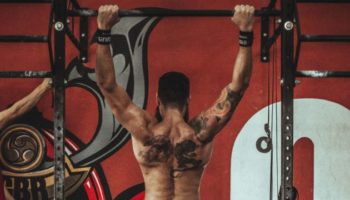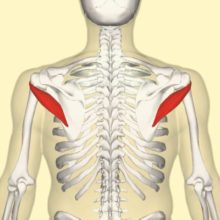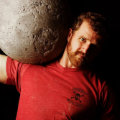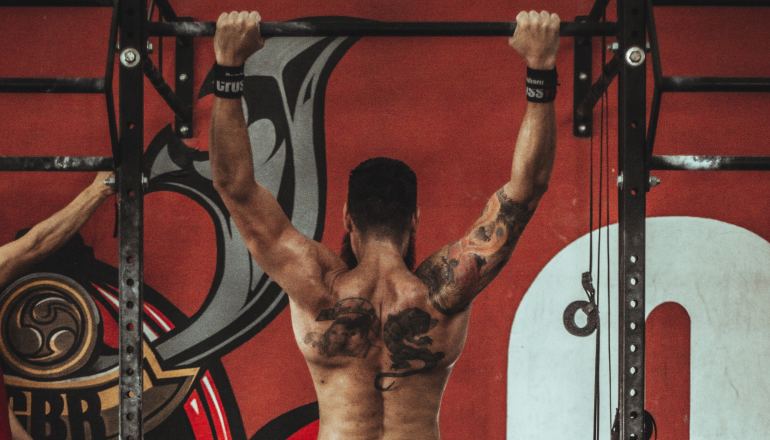 Reading Time: 5 minutes
Reading Time: 5 minutesFor athletes whose training includes frequent overhead pressing or pulling, the risk of shoulder issues is high. This is an area that must be constantly maintained so we can avoid down time from our training or, worse, surgery on our shoulders.
In my years as a coach, I’ve worked with a number of clients who had to put training on hold to recover from a shoulder issue. A few even had to work through post-surgery recovery and the slow progress that comes with that path.
To help you avoid that and keep your training on track, I’m going to focus on a muscle that few people consider when working on their overhead position and overall shoulder mobility.
How Our Teres Minor Becomes a Problem Area
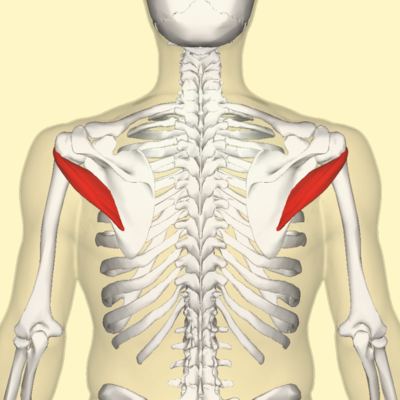 The teres minor is located at the back of the shoulder, around the arm pit. The teres minor is part of your rotator cuff. It connects the head of the humerus, the bone that connects your arm to your shoulder joint, with your shoulder blade.
The teres minor is located at the back of the shoulder, around the arm pit. The teres minor is part of your rotator cuff. It connects the head of the humerus, the bone that connects your arm to your shoulder joint, with your shoulder blade.
Since it’s located at the back of the shoulder, the teres minor has a tendency to become over-stretched due to the bad posture many of us acquire through a lifestyle of sitting. Even if you don’t sit all day, you may have posture that doesn’t fully balance the position of your shoulders. What we want is a neutral position for our shoulders — not too far forward and not too far back. Both of these unideal positions can lead to compromises in your shoulder stability and strength.
Your body is always seeking balance and when a muscle isn’t in the best position the body will try to pull that muscle back into place. When the body can’t do that on its own, the muscle in question will become tight and knotted. When you combine this situation with weight training and overhead pressing, which increase the tension and restriction developing in the muscle and the surrounding area, that muscle may become so tight it can’t function properly.
And I’m telling you all this personal experience. Many years ago, my teres minor was so tight that I wasn’t able to exert any force on it without pain. My massage therapist said it was so tight it felt like bone. It took some diligence in addressing the mobility of my teres minor, as well as taking a step back in my training, to allow it time to recover from the inflammation and tightness that had built up over years of exercise and negligence. I know how hard that all was, and I want to save you from heading down that same path.
Brush Your Teeth and Mobilize
To help you assess and improve your teres minor I’ve included a few videos that detail mobility strategies to loosen up muscle, as well as your shoulders as a whole. Some will require no equipment and others will require a minimal amount. The important thing is to remember that improvement will come by making these strategies a regular part of your routine.
If you treat your mobility work like brushing your teeth or anything else you consistently do each day, then after a while you won’t be able to go through your day without it. That’s when the benefits to your body really start to become noticeable.
How to Foam Roll Teres Minor
A great way to start addressing tightness in your teres minor and posterior shoulder is with a foam roller. I like this tool because it allows you to cover the area reasonably quickly to determine where restriction is the most severe. And, trust me, when you find the tightest areas, you know it.
Once I’ve gone over this area for a few minutes, I’ll sometimes switch to a lacrosse ball to really dig into the toughest spots. If you’re not there yet or the area is so tight that all you can manage is to lay on the foam roller for a few minutes, then that’s all you have to do. As the situation improves with time, you can move up to using a lacrosse ball if that feels appropriate to you.
Kneeling Shoulder Stretch
A great stretch for this area is to use a chair or a low table to work on your overhead extension. This stretch hits both shoulders at the same time and improves the mobility of your overhead position.
Shoulder Wall Stretch
To hit this muscle from a different angle, you can use a wall to focus the stretch on the teres minor and also get into a few of the other tissues around the underside of your arm.
Banded Overhead Stretch
If you have access to a band, then you can use it to get into an overhead position. From there you can do some active stretching to loosen your shoulders and improve your overhead range of motion.
Take Care of Your Teres Minor (and It Will Take Care of You)
A proactive approach to mobility is better than a reactive one any day of the week. It’s better to work your mobility to prevent an injury, than wait until you need to recover from one.
Take the initiative to assess your shoulders, see where any restrictions are, and make a commitment to improving the function of that area. This will keep you in the gym — and hopefully out of the doctor’s office.
